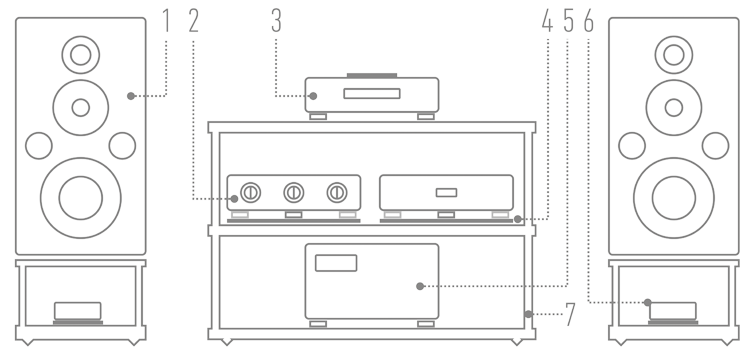|
AUDIO FILE PLAYER Lumïn
Manufacturer: PIXEL MAGIC SYSTEMS Ltd. |

|
Review
Text by WOJCIECH PACUŁA |

|
No 249 February 1, 2025 |
T3x IS AN AUDIO FILE PLAYER. It is the latest version of a device that has been on sale since 2015. It was then that the T1 file player hit the stores, in 2018 it was replaced by the T2, and in 2022 by, the aforementioned, T3. During that time, individual sections in them were changed, such as the analog output, DAC section, file transport, connectivity, chassis, and power supply. But never all at once. For example, one of the main differences between the T1 and T2 was the use of Wolfson WM8741 DACs in the former, and ESS SABRE32 ES9028Pro DACs in the latter. The former had a simple chassis and a dual linear power supply, while the latter had a much higher-end chassis and a switching power supply. 
The transition from the T2 to the T3 primarily involved a new microprocessor chip. This increased processing power, and with it, as Lumin declared, precision in file playback. It also allowed for DSD512 file playback. There were also smaller differences, such as different USB socket software, other upsampling modes, but it was mainly about the transport module. The new T3x player returns to the original concept of a linear power supply, this time an internal one, and adds an SFP optical output and a second USB socket; SFP = Small Form-factor Pluggable. From now on, it can also work as a micro LAN switch, with two inputs. | SFP SMALL FORM-FACTOR PLUGGABLE is a small transmitter/receiver that allows you to expand the functionality of your devices. The signal in it can be transmitted optically and electrically. It is also known as a mini-gigabit (Mini-GBIC) interface converter. It can be connected directly to the physical port of a network device. It can also realize electrical and optical signal conversion to increase the distance between the transmitter and receiver. 
⸜ Two SFP inputs in Lumin L2 NAS/switch SFP has long been used in audiophile systems because it galvanically isolates the system connected to the Ethernet network and audio devices, thus eliminating high-frequency interference. One of the first companies to use it on a large scale was Japan's Melco. Lumin first used it in its X1 file transport (test → HERE), and the L2 NAS drive also has it. If the file player you're using doesn't have an SFP slot, you'll need to get a converter module SFP→RJ45, such as one from Audiophile Digital Optical Technology, to connect it with optical fiber. ● ▌ T3x FEATURES • The basis of this player is a microprocessor chip, originally developed for the T3 model. Recall that at that time it was newer even than the one in the top-of-the-line X1 player and the P1 player. The microprocessor worked with a new, prepared at the time, software controlling the unpacking of files. The manufacturer said that “thanks to a significant increase in operational capabilities of the chip, it would be possible to develop upgrades, even significant ones, for the player's software for a long time.” And, as it turns out, he kept his word. The player supports almost any type of audio files: FLAC, FLAC MQA, WAV, DSD, Apple Lossless (ALAC), AIFF and mp3. It can convert files with PCM signals up to 32 bits and 384 kHz, and DSD up to DSD512. It can also convert any digital signal from unpacked files to any other value, with PCM 384 kHz and DSD256 as limits. You'll play files from local storage via network protocol, connecting via Ethernet cable to a router and NAS drive, or via one of two USB ports. The T3x can operate as the digital center of an audio system. This is made possible by the advanced digital volume control, the LEEDH PROCESSING VOLUME. The player is Roon Ready certified and allows Spotify Connect, MQA, TIDAL, TIDAL Connect, Qobuz and TuneIn internet radio streaming services, and is AirPlay compatible. The latest update added to this list is the KKBox streaming service. It was established back in 2005, but until now has been known mainly in Asia, as it mainly targets Mandarin-speaking users. TECHNOLOGY • The Lumin T3x uses two ES9028Pro SABRE D/A converters, one per channel. These operate in dual-mono mode. Each channel consists of eight DACs, which can be connected in parallel to give two, balanced analog outputs if desired. The Lumin is even more sophisticated, as it combines these eight channels into a single, mono channel. This reduces distortion and noise. The signal in analog form is routed in balanced, dual-mono form. This part was originally taken from the once top-of-the-line X1 player. One of Lumin's highlighted changes is the use of high-end, audio-specialized output capacitors, separately for XLR and RCA outputs. 
The outputs also feature separate output buffers and reed switches, acting here as circuit breakers. The signal at the outputs can be set to “High” or “Low” (level) in the device's menu, adjusting them to the rest of the system. The idea is to make the Leedh volume control work with the highest possible values (as little “attenuation” as possible). From the classic 2 V for RCA and 4 V for XLR, we can go to - respectively - 3 and 6 V. This section looks identical to the one in T2 and similar to the X1 output circuit. CONTROL • One of the key features of Lumin's devices is the company's own Lumïn App control application, developed right at the beginning. This is usually the bottleneck of systems of this type. The one developed for Lumin is really easy to use and handy. It is available for both smartphones and tablets. However, it is also true that apps from Roon and now JPLAY have set the bar much higher, and a solid update of the Lumin app would be useful. ▌ SOUND HOW WE LISTENED • The Lumin T3x audio file player stood on a Finite Elemente Pagode Edition Mk II rack. On its top panel I placed a Verictum X Block passive EMI/RFI filter. Its sound was compared to the Lumin T3 and the AYON AUDIO CD-35 HF EDITION SACD player. I listened to files played from Tidal and from a NAS drive - this is our latest acquisition, the Lumin L2, with SSD drives. 
With the router, the player was connected via my system consisting of a SILENT ANGEL N16 LPS dual LAN switch, with its two modules in series, powered by a TIGLON TPL-2000A cable. The signal from the switch to both players was carried by a LAN Quadrant Triple-C cable with RLI-1GB Triple-C filters at both ends. For the first time, I reached for a power system, consisting of an Essential Audio Tools Myni power strip (test → HERE) to which the Acrolink 8N-PC8100 Performante Nero Edizione (№ 1/15) cable supplied the voltage. This system powered both file players and the NAS drive. » RECORDING USED FOR THE TEST ⸜ a selection
⸜ CAT STEVENS, Tea for the Tillerman, Island Records/Universal Island Records/Tidal, FLAC 24/96 (1970/2012). » The recordings featured in the test can be found on the HIGH FIDELITY playlist on TIDAL → HERE HOW ABOUT THIS DIGITAL TECHNOLOGY! Seemingly transparent, simple, amenable to calculation and planning, “accessible” to anyone with any understanding of computers. Phenomena with such characteristics are referred to as “transparent”. And maybe that's why almost everyone thinks they know everything about it, that its mysteries are no longer mysteries, but simple puzzles that they will solve between a pizza and a Coca-Cola. The truth is that when it comes to the specific use of digital technologies, as in the case of audio, we still know very little. Because a comparison of the two Lumin players, which are separated primarily by the type of power supply - SMTP vs. linear - shows that even such small changes translate into sound in a surprising, because non-intuitive, way. For, behold, the new Lumin T3x plays in a more expressive, more dynamic and more energetic way than its earlier version. And, that's the “story” after all, SMTPs “skinny up” the sound, while linear ones add some weight to it, making it - really, some people think so - more “analog,” whatever that word-bag means in their mouths. The first few strokes of an acoustic guitar, with nylon strings, starting ˻ 3 ˺ Wild World, CAT STEVENS' all-time hit from his album Tea for the Tillerman, and we already know - this is different sound. Yusuf Islam's vocals, as the artist is called today, were closer to me and had a clearer edge than before. Listening to the same song on the T3, it was easy to point out that the overall sound was warmer, a bit more “round” and more saturated in the upper midrange and mid-bass. With the T3x, the foreground was closer to me, and was also clearer and more unambiguous. 
The older player built a deeper stage, further away from the line connecting the speakers. And it was not as clear as with the new Lumin, this was acutely clear to me from the very beginning. Perhaps that's because the tested player builds sound a bit higher on the scale. Yes, it goes low and deep on the bass. But, such is my impression, it does it with less conviction, if I may anthropomorphize it that way. In the sense that when the first chord from the TAMINO’S ˻ 2 ˺ Babylon, the second track of this British-Egyptian singer's new single, rings out, everything momentarily “falls” into its place, tight, dense and dark, because that's how its producers wanted it to sound like. |
When, on the other hand, in the middle of the third minute, in the chorus, the voice and strings are “released” backwards through a long reverb, the new Lumin allows the whole to open up, to widen the stereoscopy, as if we had suddenly entered a large hall. Spatial differentiation is thus preserved, it is not a flattening of the stage. The T3x zooming in on the foreground does so without modifying what happens behind it. And that's because it does so through a more pronounced attack, not through lower resolution. The vitality of the presentation benefits from it. The tested player delivers stronger sound, more “forward” sound. This is why rock recordings sounded exciting and fresh with it. As if we were sitting at a concert rather than in front of the speakers. And yet still with a certain Lumin mannerism, a mannerism I like, involving a slight warming of the attack. That's why JACK WHITE in You Got Me Searching seemed stronger, his guitar more biting, clearer. White, as we all know, is a fan of classic recording techniques, so he records in his studio on an analog tape recorder, using vintage microphones and studio equipment. The website of his Third Man studio reads:

And you can clearly hear that. The tested player very nicely conveyed the “patina” that this type of treatments brings to the sound. Because the sound was low, based mainly on midrange and upper bass. But after all, this was not a dull sound, so there was a lot of energy, power, and slam in this playing. If I had to compare it to something, it would be the playing of Rick Rubin's records (Slayer, Red Hot Chili Peppers, Johnny Cash) rather than Steve Albini's (Pixies, Nirvana), although both are absolute fans of analog. And yet... It is, as I say, still Lumin. Sometimes it happened that the new devices from this company sounded different from what we are used to from this Hong Kong-based manufacturer. That is, brighter, stronger, clearer. To be honest, I think this is not the way to go, this is not what we are used to, and this is not where I see its advantages. The T3x goes in that direction, that's for sure, but it doesn't cross the boundary of conventional “good taste”. It combines the warmth and saturation of the T3's tonality with a stronger attack and more pronounced treble. And I guess that's what it is about, finding a solution for those for whom the T3 was too dark, too warm, and too conservative. The T3x may prove to be the “golden mean” for anyone to whom the T3, D2, P1 Mini, and earlier T2 seemed just that, but who appreciated their soft, pleasant sound. It does not saturate the sound as much as the older player from the “T” series, nor is it so ‘syrupy’. It plays with more nerve, accentuating the impact more precisely. The cymbals from the right channel in MILES DAVIS’ ˻ 1 ˺ So What were clearer and more “lit up.” Likewise, by the way, was John Coltrane's saxophone, which rings out in the left channel in the middle of the fourth minute. So we're talking about a sound that balances opening and warmth. And it does it really well. It's just as versatile as the T3, or maybe even more so. Because, and yet!, it differentiates the sound better. The powerful trumpet in ˻ 5 ˺ Strange Fruit, a track from the BILLIE HOLIDAY album entitled Lady Sings The Blues, was clearer and had more energy. It was just big and more “present.” Also the reverb, this time long, but with a lower volume superimposed on the vocals, was clearer. When the artist abruptly ends a phrase, along with the piano, it carries on for a while longer with quiet reverberation. With the T3 and cheaper players from this company, as far as I can remember, these kinds of subtleties were slightly buried in the warmth, in the saturation of the bass, in the “mist” of dense sounds. The tested player brings them back, showing more information from the recording; as I say, it is simply more resolving. It's still Lumin's sound, however; the company is keeping it within the boundaries already outlined with its first device from 2013, called simply Lumin. It is, however, its right side. That is, more aggressive, more expressive. But even recordings of the kind of PÊ-TLA by NOON and VKIE, actually by Lukasz Liszka, that is composed of samples, beats, fragments, will not be too aggressive and too bright. It will be a very good mix of one and the other approach to musical matter. ▌ Summary THE NEW LUMIN PLAYER is at the same time a very versatile device. Played right after PAOLO FRESU's Noon with the track ˻ 2 ˺ Autumn Leaves (Take One), from a perfect recording, sounded equally cool, equally energetic. The bass was also low and powerful here, but - this is important to know - less saturated than in the T3. Instead, it was better defined in terms of timing. Therefore, the company's new player seems to fit better and easier in more audio systems than the T3. Especially since it does not have to be “tailored” for this type of sound, as the device is nicely tonally balanced. All you need is a system with well-arranged priorities, the kind we want, and the T3x will bring energy and vitality to it, but also dense timbres, saturated sound and a touch of warmth. ▌ DESIGN THE LUMINN T3x PLAYER CHASSIS follows the “company line” this manufacturer invented with its first device. It is rigid, and is made from aluminum elements and plates bolted together. These include the two side panels, the rear and front panels, as well as the bottom and top. All the parts are solid, thick and perfectly fitted together. The T3x uses exactly the same chassis as the previous T3, they differ only in the rear panels. The unit stands on four aluminum feet screwed from the bottom. So they can easily, I think, be replaced with some other ones from vibration damping specialists. The unit is available in silver (natural aluminum) or black. 
FRONT AND REAR • The displays of Lumin products have a blue color given by filters set before the actual display module. Interesting, but the hue on the T3x is slightly different from that on the T3 and the NAS L2. The display is not large. It reads the name of the artist, the title, and audio signal parameters, with all the details. A circular bar-graph will show the duration of the song, repeated with numbers. If you use the volume control, you can select the corresponding display instead. The rear panel is what makes the T3 and T3x players different. The analog section is the same, and that's because the electronics of this stage have not changed either. The signal is output through widely spaced sockets, which helps when connecting, analog cables - RCA and XLR. The former are manufactured by the American company CMC. Unlike products from other companies, the ground contact surface is not polished, but slightly rough. There are no markings on XLR sockets, but their contacts appear to be silver plated. We can send the digital signal in the form of S/PDIF out via two links: BNC and USB. The former was chosen by Lumin, in place of the commonly used RCA, right at the beginning of the business. This is a truly engineering approach to the problem, as it's the only way to perfectly maintain the characteristic impedance of the 75 Ω S/PDIF digital output. All the more so because an impedance matching transformer was introduced before it. Next to it you can see something familiar from the company's more expensive products and the L2, namely an SFP optical socket. Together with the LAN socket next to it, it forms a LAN micro-switch - both are active all the time. Instead of one USB socket, as in the T3, there are two here. And there is also a grounding terminal. Unfortunately, it is not very convenient to use, I would have preferred a classic speaker jack. At the extreme right is still an IEC power socket with a power switch next to it. It has a vertical orientation, while in the T3 it was horizontal. INSIDE • The electronic circuit looks identical to the one in the T2 and then the T3. The difference between the two was the replacement of the, mounted with multi-pins, microprocessor with external memory. The T3 and T3x look almost exactly the same, except for the section right next to the digital outputs. Next to it you can see the DSP chips, Altera Cyclone IV and XMOS. The first one is used for upsampling and realizes volume control, and the second is a USB receiver. The player's software was developed by Pixel Magic Systems engineers and is constantly being improved. The main change in the new player is the replacement of the SMPS with a linear power supply. Let me remind you that in the T1 version it was an external linear power supply, only in the T2 it was swapped for a pulsed one. So with the T3x, we return to the first solutions of this manufacturer. The model featured a toroidal transformer from the Canadian company Piltron, only that it was manufactured in China. It will be interesting to see when the West will finally wake up and return to producing such components themselves. Like our homegrown company toroid.pl. 
The DAC section has not changed compared to the T2 model. The signal goes to two Sabre ES9028PRO chips from ESS Technology, one per channel, operating in mono mode. Behind them you can see the current-to-voltage and output circuits. They are based on OPA 1611A integrated circuits. Working with them are nice WIMA polypropylene capacitors and surface-mount resistors. The outputs are capacitor-coupled using nice Nichicon Muse elements - the manufacturer pays special attention to it in its press materials. The outputs are switched by reed switches - these are some of the best, most stable switching elements. Another company that uses them is MCINTOSH. The signal, from start to finish, is routed in balanced form. ● ▌ Technical specification (acc. to the manufacturer)
Streaming protocol: UPnP AV 
THIS TEST HAS BEEN DESIGNED ACCORDING TO THE GUIDELINES adopted by the Association of International Audiophile Publications, an international audio press association concerned with ethical and professional standards in our industry, of which HIGH FIDELITY is a founding member. More about the association and its constituent titles → HERE. |

|
Reference system 2025 |
|
 1) Loudspeakers: HARBETH M40.1 |REVIEW| 2) Line preamplifier: AYON AUDIO Spheris III Linestage |REVIEW| 3) Super Audio CD Player: AYON AUDIO CD-35 HF Edition No. 01/50 |REVIEW| 4) Stands (loudspeakers): ACOUSTIC REVIVE (custom) |ABOUT| 5) Power amplifier: SOULUTION 710 6) Loudspeaker filter: SPEC REAL-SOUND PROCESSOR RSP-AZ9EX (prototype) |REVIEW| 7) Hi-Fi rack: Hi-Fi rack: finite elemente MASTER REFERENCE PAGODE EDITION Mk II, more → HERE |
|

|
Cables Analog interconnect SACD Player - Line preamplifier: SILTECH Triple Crown (1 m) |ABOUT|» ANALOG INTERCONNECT Line preamplifier → Power amplifier: Siltech ROYAL SINLGE CROWN RCA; review → HERE Speaker cable: SILTECH Triple Crown (2.5 m) |ABOUT| |

|
AC Power Power cable | Mains Power Distribution Block - SACD Player: SILTECH Triple CrownPower (2 m) |ARTICLE| » POWER CABLE Mains Power Distribution Block → Line preamplifier: Acoustic Revive ABSOLUTE-POWER CORD, review → HERE » POWER CABLE Mains Power Distribution Block → Power amplifier: Acoustic Revive ABSOLUTE-POWER CORD, review → HERE Power cable | Power Receptacle - Mains Power Distribution Block: ACROLINK Mexcel 7N-PC9500 (2 m) |ARTICLE| Power Receptacle: Acoustic Revive RTP-4eu ULTIMATE |REVIEW| » ANTI-VIBRATION PLATFORM under Acoustic Revive RTP-4eu ULTIMATE: Graphite Audio CLASSIC 100 ULTRA, review → HERE Power Supply Conditioner: Acoustic Revive RPC-1 |REVIEW| Power Supply Conditioner: Acoustic Revive RAS-14 Triple-C |REVIEW| Passive filter EMI/RFI: VERICTUM Block |REVIEW| |

|
Anti-vibration Speaker stands: ACOUSTIC REVIVE (custom)Hi-Fi rack: finite elemente MASTER REFERENCE PAGODE EDITION Mk II, more → HERE Anti-vibration platforms: ACOUSTIC REVIVE RAF-48H |ARTICLE| » ANTI-VIBRATIONAL FEET: |

|
Analogue Phono preamplifier: Phono cartridges:
Clamp: PATHE WINGS Titanium PW-Ti 770 | Limited Edition Record mats:
|

|
Headphones » HEADPHONE AMPLIFIER: Leben CS-600X, review → HEREHeadphones: Headphone Cables: Forza AudioWorks NOIR HYBRID HPC |
main page | archive | contact | kts
© 2009 HighFidelity, design by PikselStudio,
projektowanie stron www: Indecity
















